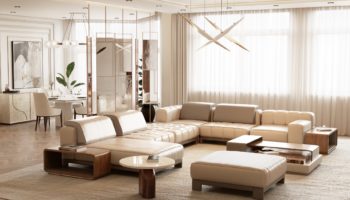Fractal Table by Materialise and Platform Studio
Like many world-changing innovations from the Manhattan Project and beyond, the inscrutable Fractal.MGX Coffee Table required a consortium of international talents to bring the notion to fruition. This is because the concept is especially complex, challenging, as it does, our notions of knowledge from both philosophical and physical perspectives. And when I say “physical,” I refer to the sub-atomic intricacies of matter, perhaps better framed in the question, “what shape is a tree?”
Fractal Table. Designed by Materialise and Platform Studio.
Fractal.MGX attempts to answer that query by learning how to build in the same way nature does. In the case of this particular piece, that involved the talents of Gernot Oberfell and Jan Wertal (principals of Platform Design), Designer Matthias Bär, and the Belgian company Materialise, whose .MGX technology is another name for “3D printing… also known as additive layered fabrication (ALF) or rapid prototyping, which involves a three-dimensional image that is literally ‘printed’ as a 3D object. Objects can be created in one piece, without seams or joints and without the use of moulds, but with the most astounding levels of intricacy and functionality.”


There’s no small quantity of technalese therein, but what else could one expect from a product based on the math-heavy notion of fractals? And how, then, to summarize the revolutionary technique? For simplicity’s sake, let’s just say that fractals are smaller parts of an original whole; and that trees, in their rigid insistence to “branch off” (from trunk to main branches to peripheral branches, to an intricate weave of diminutive stems) grow by a process of exponential “fractalification,” for lack of a better word. The Fractal Table aspires towards the very same branching habit via application of matematical formulae and CAD technology to produce a table “comprised of treelike stems which grow into smaller branches until they get very dense towards the top.” The technology allows mould-free production of the very same–“Manufactured as a single piece, without seams or joints, using stereolithography and epoxy resin.”
Fractal.MGX represents one more achievement in the move toward understanding and mimicking the astounding carpentry of nature (or God, call it what you will), other manifesations of which include the Quasi Console, the Gaudi Stool, and the Vegetal Chair. Fractal is definitely an astounding achievement–it’s a bold foray into comprehending and utilizing organic forms. But if the intent is to somehow “copy nature,” it doesn’t accomplish that at all. The great thing about Fractal is that it takes its aesthetic cues from the natural world, yet manages to maintain its own rigidly geometrical aesthetic. This aesthetic, In the words of Materialise, evinces “the merging of design, art, nature, and technology to take the concept of beauty to a new level.”




Leave a Reply